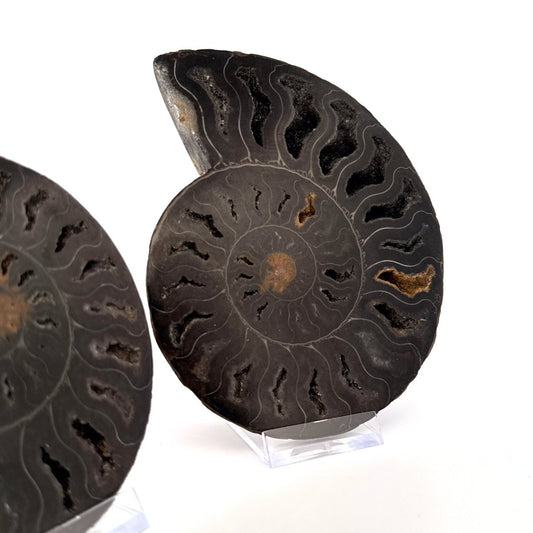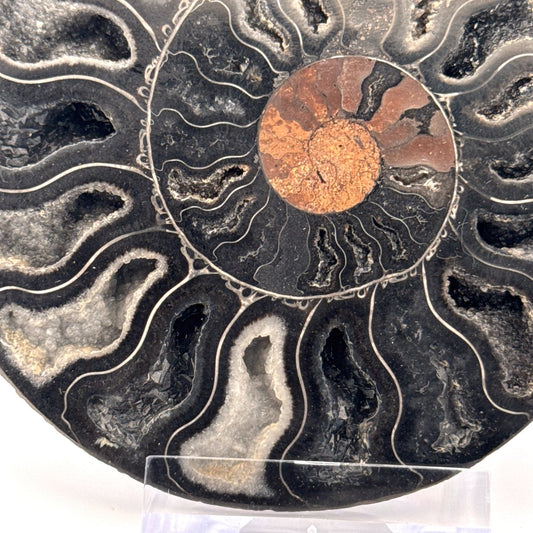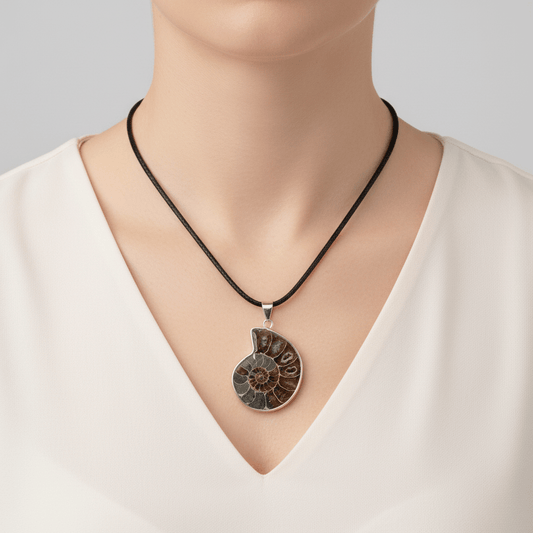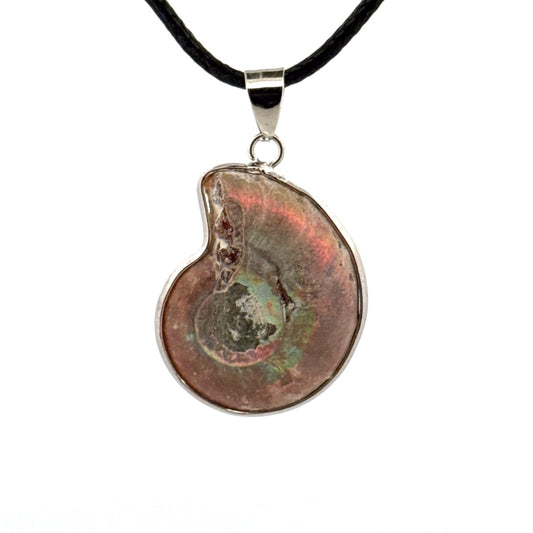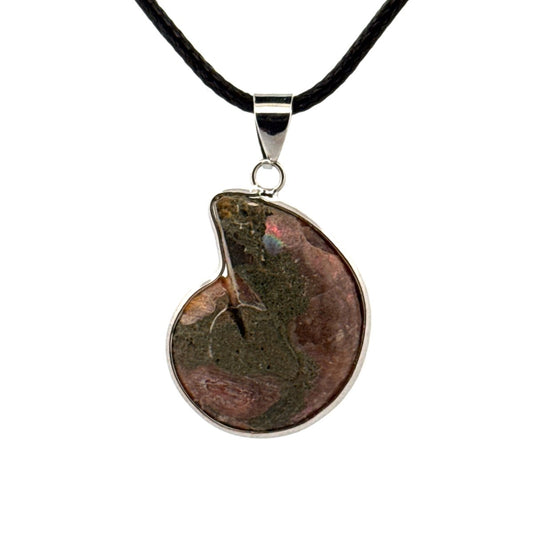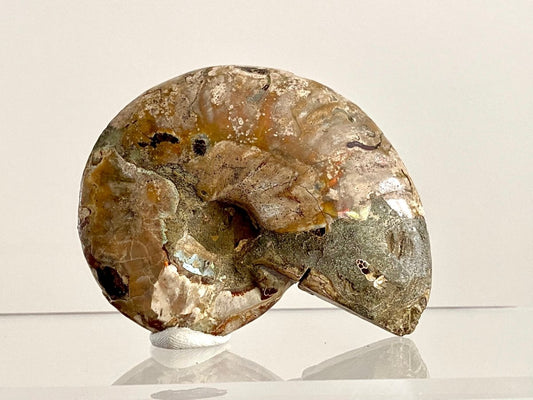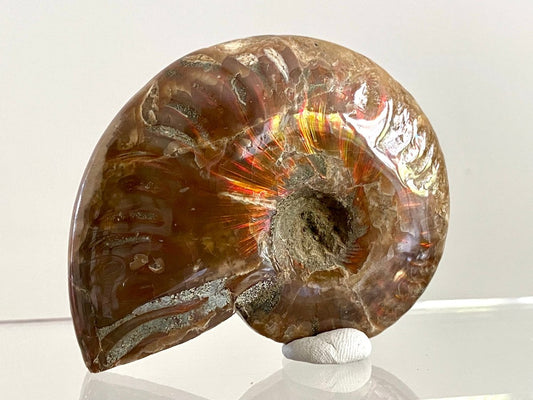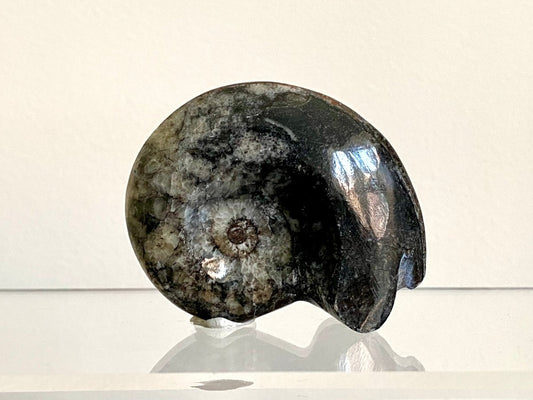Collection: Ammonite fossils for sale
Extinct marine mollusks that belong to the cephalopod class. They first appeared around 400 million years ago and became extinct approximately 66 million years ago. Ammonites had spiral shells with intricate chambers, and their closest modern relatives are squids and octopuses.
Ammonites possessed the ideal attributes to thrive across diverse habitats and endure for nearly 300 million years. Their widespread presence during this period, rapid evolutionary diversification, and the composition of their shells make them ideal candidates for fossilization.
Learn more about ammonites
-
Cut and Polished Cleoniceras Ammonite Fossil (5.53") – Cretaceous, Madagascar
Regular price €92,50 EURRegular priceUnit price / per -
Cut and Polished Cleoniceras Ammonite Fossil (4.47") – Cretaceous, Madagascar
Regular price €42,50 EURRegular priceUnit price / per -
Ammonite Pendant on necklace – Fossil Jewelry from Madagascar
Regular price €17,50 EURRegular priceUnit price / per -
Ammonite Pendant on necklace – Fossil Jewelry from Madagascar
Regular price €17,50 EURRegular priceUnit price / per -
Ammonite Pendant on necklace – Fossil Jewelry from Madagascar
Regular price €17,50 EURRegular priceUnit price / per -
Cleoniceras Ammonite Fossil (3.20") – Cretaceous Period, Madagascar
Regular price €11,00 EURRegular priceUnit price / per -
Cleoniceras Ammonite Fossil (2.99") – Cretaceous Period, Madagascar
Regular price €12,50 EURRegular priceUnit price / per -
2.18” Devonian Goniatite fossil from Morocco
Regular price €8,95 EURRegular priceUnit price / per -
1.88” Devonian Goniatite fossil from Morocco
Regular price €8,95 EURRegular priceUnit price / per -
2.16” Devonian Goniatite fossil from Morocco
Regular price €8,95 EURRegular priceUnit price / per -
2.05” Devonian Goniatite fossil from Morocco
Regular price €8,95 EURRegular priceUnit price / per -
5.65" Ammonite Fossil, Cleoniceras species (2-sides, cut and polished)
Regular price €81,50 EURRegular priceUnit price / per -
5.06" Ammonite Fossil, Cleoniceras species (2-sides, cut and polished)
Regular price €62,50 EURRegular priceUnit price / per -
5.80" Ammonite Fossil, Cleoniceras species (2-sides, cut and polished)
Regular price €87,00 EURRegular priceUnit price / per -
6.49" Ammonite Fossil, Cleoniceras species (2-sides, cut and polished)
Regular price €125,00 EURRegular priceUnit price / per -
5.67" Ammonite Fossil, Cleoniceras species (2-sides, cut and polished)
Regular price €95,00 EURRegular priceUnit price / per
About Ammonites
Spiraling Fossils of Ancient Seas
Ammonites were a diverse group of marine mollusks belonging to the class Cephalopoda and the subclass Ammonoidea. These fascinating creatures inhabited Earth's oceans for over 300 million years, from the Devonian period to the end of the Cretaceous period. Known for their distinctive spiral shells, ammonites were widespread and abundant, playing key roles in ancient marine ecosystems.
Anatomy and Shell Structure
Ammonites had coiled shells divided into chambers separated by walls called septa. As the ammonite grew, it would add new chambers to its shell, gradually increasing in size. The final chamber, known as the body chamber, housed the soft body of the animal, including its head, tentacles, and other internal organs. The outer surface of the shell, known as the suture line, featured intricate patterns of ridges and grooves, which varied in complexity among different species.
Habitat and Distribution
Ammonites inhabited marine environments worldwide, from shallow coastal waters to deep oceanic trenches. They could be found in a variety of habitats, including reefs, open oceans, and sandy bottoms. Fossilized ammonites have been discovered on every continent, providing valuable information about ancient marine ecosystems and paleogeography.
Ecology and Behavior
Ammonites were active predators, using their tentacles and beak-like jaws to capture and consume prey such as small fish, crustaceans, and plankton. Some species may have also been scavengers or filter feeders, depending on their specific adaptations and ecological niches. Ammonites were an important part of the marine food chain, serving as prey for larger predators such as marine reptiles and sharks.
Evolutionary History
Ammonites evolved from earlier cephalopods during the Devonian period and diversified rapidly during the subsequent periods. They underwent numerous evolutionary adaptations, leading to a wide variety of shell shapes, sizes, and ornamentation patterns. Ammonites reached their peak diversity and abundance during the Mesozoic era, with some species achieving large sizes comparable to modern-day dinner plates.
Extinction and Fossilization
Like many other marine organisms, ammonites became extinct at the end of the Cretaceous period, approximately 66 million years ago, during the mass extinction event that also wiped out the non-avian dinosaurs. The exact cause of their extinction remains uncertain, but factors such as climate change, habitat loss, and competition with other organisms likely played a role. Fossilized remains of ammonites are abundant and widely distributed, providing valuable insights into Earth's ancient oceans and the processes that shaped life on our planet.
Cultural Significance
Ammonites have captured the imagination of humans for centuries and have been revered as symbols of beauty, strength, and mystery. Their spiral shells have inspired art, literature, and mythology throughout history, symbolizing concepts such as eternity, regeneration, and the cyclical nature of life. Today, fossilized ammonites are prized by collectors and enthusiasts for their scientific, aesthetic, and historical value.
Ammonites are iconic symbols of Earth's ancient oceans, representing a diverse and successful group of marine organisms that thrived for millions of years. Through their distinctive shells and rich fossil record, ammonites provide valuable insights into the evolutionary history of life on our planet and the dynamic nature of ancient marine ecosystems. As scientists continue to study and explore the world of the ammonites, we gain a deeper understanding of the interconnectedness of life and the ever-changing landscapes of Earth's distant past.
Ammonite fossils for sale


